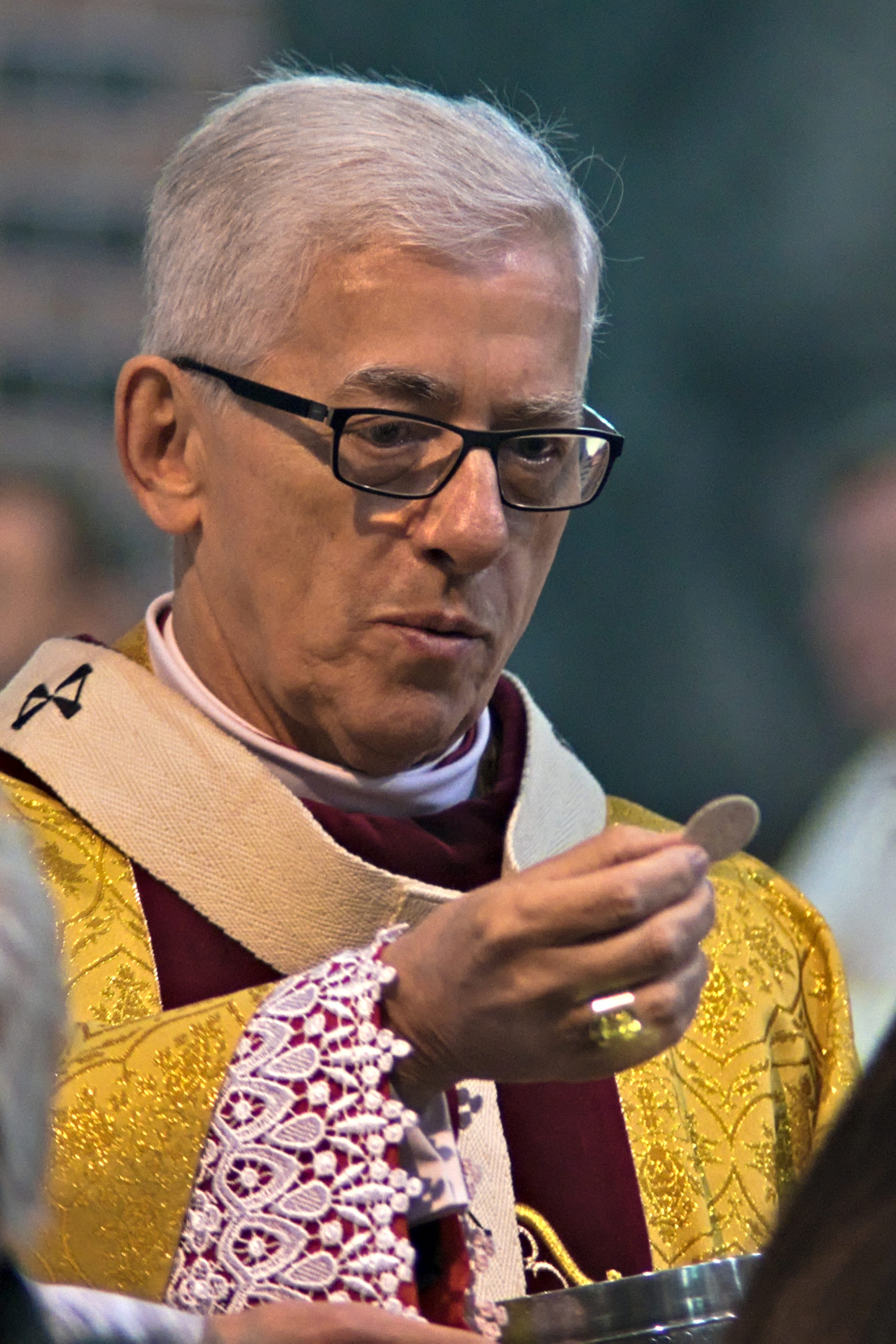
Did Pope Alexander VI Authorize England’s Colonization of North America?
Matthew P. Cavedon
Archbishop Adrian Tync. Wikimedia CC BY-SA 4.0
This article is part of our “200 Years of Johnson v. M’Intosh: Law, Religion, and Native American Lands” series.
If you’d like to check out other articles in this series, click here.
Shortly before Thanksgiving 2016, Episcopalian priest John Floberg held up a copy of Pope Alexander VI’s 1493 papal bull Inter caetera before a crowd of hundreds of protesters and clerics at North Dakota’s Oceti Sakowin Camp. He asked a committee of Indigenous elders to authorize its burning. They did, the paper went up in flames, and the crowd erupted in applause.
Why torch the text? Those present believed, as do many activists today, that Inter caetera was the basis for the English colonization of North America and later U.S. claims to the land formerly held by Indigenous peoples. Early American legal precedent took this view. But that belief is wrong as a matter of history. Inter caetera’s only function in English colonization was as a foil — a symbol of the narrow-minded, theocratic, Catholic Spanish foe. It was emphatically not the historical basis for Anglo-American colonialism.
The English rejected papal authority
The papal bull (named for its official seal, called a “bulla” in Latin) Inter caetera says that Alexander will “give, grant, and assign” to the monarchs of Castile (and, by extension, their Spanish successors) “all islands and mainlands found and to be found” to the west and south of the Azores and Cape Verde, including “all their dominions, cities, camps, places, and villages, and all rights, jurisdictions, and appurtenances” (77). This language’s meaning and legal implications (especially for the Spanish and Portuguese empires) are complex. But Inter caetera did not lend any authority to England’s imperial endeavors, nor those of the other non-Iberian powers.
English imperial adventurism did not begin with Alexander. It began with [King] Henry [VII] skirting or directly contradicting Inter caetera. Henry would not be the last Englishman to do so.
English colonialism in North America can be traced to 1496. King Henry VII (1457-1509) issued letters patent to John Cabot (c.1450-1499) that “were to some degree an attempt to replicate the language” of Inter caetera (5). At the outset, whether Cabot’s voyage was meant to inaugurate a world empire is not clear. He journeyed in a small ship and the only benefit he was given was a monopoly of access against other English land claimants (367). His letters did not assert any prospective title over territories to be discovered. Cabot arguably held nothing more than a license to explore and a promise that Henry would protect his claims if he succeeded in taking any land as a royal vassal.
But the fact that Henry even issued Cabot’s letters illustrates how little authority England ascribed to Inter caetera. According to the bull, only Spain and Portugal were to colonize west of the Azores and Cabo Verde. But Henry authorized Cabot to cross that line. English imperial adventurism did not begin with Alexander. It began with Henry skirting or directly contradicting Inter caetera. Henry would not be the last Englishman to do so (87-88). Within two generations, England had transformed itself from a Catholic kingdom willing to disobey papal decisions to a new Protestant power rejecting papal authority altogether. Leading legal historian James Muldoon recounts that a “representative of Henry VII’s Protestant granddaughter, Elizabeth I (1558-1603), bluntly told Spain’s ambassador that ‘the Pope had no right to partition the world and to give and take kingdoms to whomsoever he pleased’” (98).
In 2018, Canada’s Assembly of First Nations declared that colonization ‘started with the Pope’ and that it deserved ‘the respect of having the Pope himself apologize and support our efforts to rebuild our Nations’
In the early seventeenth century, England first undertook permanent colonization along North America’s eastern shore. To be sure, early colonial charters expressed religious aims. Virginia’s 1606 charter, issued by King James I (r. England 1603-1625), emphasized settlers’ “responsibility to propagate the ‘Christian Religion to such People, as yet live in Darkness and miserable Ignorance of the true Knowledge and Worship of God, and . . . in time bring the Infidels and Savages . . . to human Civility, and to a settled and quiet Government’” (371). Such documents shared evangelical objectives with Inter caetera. But it was Anglicanism headed by the monarchs — not the Catholicism of Alexander and later popes — that England’s colonists were supposed to transplant to the newfound continent.
Englishmen of the day attacked Inter caetera as illegitimate (358). Richard Hakluyt’s 1584 Discourse Concerning Western Planting, for example, lamented the bull as a “most unreasonable and injurious donation” and called Spanish colonists “hellhounds and wolves” who injured Indigenous peoples instead of converting them (199). Hakluyt promoted English colonization as a way of protecting natives and European Protestants alike from Catholic tyranny. Encouraging settlement in Virginia in 1607, Robert Johnson wrote of Inter caetera, “what is this to us? they are blind indeed that stumble here.” In 1629, John Winthrop, who would soon set sail as the first governor of the Massachusetts Bay Colony, described Iberian colonies as part of the “kingdome of Antichrist” (that is, the Catholic Church) (28). For early English imperialists, the popes were no benefactors. They were boogeymen.
Early American law’s historical amnesia
Why have many modern commentators forgotten the English disregard for papal authority generally, and Inter caetera specifically? Possibly because some early American courts distorted the history. Inter caetera was cited by early decisions of the highest court of Tennessee, which, at the time, was still a frontier home to both white settlers and Cherokees. The court’s 1826 decision in Cornet v. Winston’s Lessee looked to colonial legal history to make sense of contemporary Indigenous land title. It interpreted previous law in light of what it considered “the prevailing opinions of those days in matters of religion,” positing that popes “dictated the creed of the people” and their “grants of infidel countries were considered binding.” Although “papal pretensions were curbed” by the Protestant Reformation, Europe’s monarchs did not reject the theory of universal papal power. Instead, they claimed such power for themselves because it “could not be safely entrusted in the hands of pontifical ambition.” By this logic, European sovereigns could extinguish Indigenous land titles because non-Christians “were no less subjects of the devil than they had been before; and might justly be deprived of all their possessions.” Oversimplifying centuries of relatively nuanced Catholic canon-law debates about these matters (and varying Protestant receptions of that tradition), Cornet flatly denied rights to non-Christians.
The same court erred again in State v. Foreman (1835), holding that a single “law of Christendom” governed all colonization: “discovery gave title to assume sovereignty over, and to govern the unconverted natives of Africa, Asia, and North and South America.” The court seemed to sense something amiss in ascribing to Protestant England reliance on papal authority, but concluded that the legal history was straightforward anyway:
[T]he principle declared in the fifteenth century as the law of Christendom, that discovery gave title to assume sovereignty over, and to govern the unconverted natives of Africa, Asia, and North and South America, has been recognized as a part of the national law, for nearly four centuries . . . . [I]t is our duty not to shrink from a principle on which the title and value of Louisiana depend, either because modern casuists condemned it, or because the Popes of Rome made, and by the force of their once sovereign authority, established it. Its promulgation may have been a harsh fiat, and it may have been cruelly executed by the Spaniards in Peru and Mexico; yet it is the fiat of our recognition, from the Catholic reign of Henry the Seventh, through every change of religion and government in England, by the colonies up to the revolution, and the States having Indian relations since.
One of the justices on the Foreman court knew better. Concurring in the decision, Justice Nathan Green wrote that “the doctrines avowed in the bulls of the pope . . . were never maintained by the English monarchs, nor practised upon by the colonists from that country; but have been condemned by all Protestant writers.”
But, over time, the Tennessee court’s mistaken view in Cornet and Foreman achieved prominence. Foreman’s author, then-state Chief Justice John Catron, rose to the U.S. Supreme Court in 1837, nominated by fellow Tennessean (and ardent supporter of white expansion into Indian lands) President Andrew Jackson. In 1850, Catron cited Cornet as a persuasive authority in writing the Court’s opinion in Marsh v. Brooks. Even before then, in 1844’s Ladiga v. Roland, the Court had praised Cornet as “able and sound.” Marsh, in turn, was cited as authority (albeit for a different principle) as recently as the Court’s 1985 decision in County of Oneida v. Oneida Indian Nation. Bad history thus became embedded in Indian law precedent.
Activist focus on Inter caetera reflects the distorted legal history
Rev. Floberg’s immolation of Inter caetera was the fruit of decades of scholarship and activism. An early assessment of the bull by a modern Indigenous scholar appears to have been by prominent Lakota academic Vine Deloria Jr. In 1972, he wrote an “Open Letter to the Heads of the Christian Churches in America.” In it, he argued that a “gradual consensus” had emerged among early modern Christians that Indigenous land claims were subject to the rights of European empires. Two years later, Deloria named Inter caetera a part of that consensus. However, he did not see the bull as the font of original imperial evil, noting that it played an important role only in Spanish and Portuguese claims. He even said the “doctrine of discovery” took on life only later, after those two powers signed the bilateral Treaty of Tordesillas.
However, it was not Inter caetera’s destiny to remain a minor part of American historical memory. In 1992, as the quincentennial of Columbus’s first voyage approached, the Traditional Council of Indian Elders and Youth denounced the bull as a foundation of this nation’s unjust legal history (340-341). Two years later, the Onondaga Nation did the same. In 2006, even Deloria wrote that Inter caetera enshrined the belief that “God appointed the Pope to rule over planet earth until the Second Coming of Jesus” and “produced for many of the world’s people a kind of legal limbo where justice could not be served, nor was it ever intended to be served” (106-107).
The Commission relied on the work of Jennifer Reid, who characterized Alexander’s words as ‘the legal foundation upon which North America was colonized.’
Inter caetera’s centrality to activist demands reached a new level in 2007 when a Native American delegation asked the Holy See’s UN mission for a formal response to the bull. Three years later, the mission answered that Inter caetera was a mere “historical remnant” (which is wrong in the Spanish context but, if anything, an exaggeration in the English one) (2). In 2016, the Canadian Conference of Catholic Bishops weighed in, correctly noting the absence of any “clear, universally held set of beliefs about land rights held by all Europeans during the Age of Discovery” (app’x at 6).
But criticism of Inter caetera saw a resurgence in 2015, when the Catholic Church canonized as a saint the Spanish California missionary bishop Junípero Serra, and Canada’s national Truth and Reconciliation Commission declared that English-derived indigenous law arose “smoothly and relatively uncritically” from Catholicism (192). The Commission relied on the work of Jennifer Reid, who characterized Alexander’s words as “the legal foundation upon which North America was colonized.” In 2016, an Indigenous delegation met with Pope Francis and asked him to renounce Inter caetera. In 2017, the Onondaga Nation’s general counsel, Joseph J. Heath, wrote that the bull was “adopted” by the English, so papal rescission would cast doubt on federal Indian law (116-117, 120). In 2018, Canada’s Assembly of First Nations declared that colonization “started with the Pope” and that it deserved “the respect of having the Pope himself apologize and support our efforts to rebuild our Nations” (6).
Criticism of Inter caetera reached its apex during Pope Francis’s 2022 “penitential pilgrimage” to Canada to apologize for the Catholic Church’s role in abuses against First Nations, especially in Church-run residential schools. Moments before Francis began to say Mass at a Quebec basilica, protesters unfurled a huge banner reading “RESCIND THE DOCTRINE.” They were following the errors of nineteenth-century American jurists and not the actual historical record in attributing responsibility to the Bishop of Rome for England and France’s colonization of Canada.
Conclusion: Pope Francis should respond with nuance
Ahistorical protests like this nonetheless caught the Vatican’s attention. After Pope Francis returned to Rome, the Canadian bishops announced that they were working with Vatican officials on a new statement “rejecting an entire tradition of legal reasoning.” They should focus on Iberian imperialism and intellectual connections between Christianity and imperialism writ large. Catholic canon law dating from before Inter caetera led to both the bull and other rationales for dominating Indigenous peoples, as Lumbee scholar Robert A. Williams has helpfully observed in correspondence with me. Pope Francis can certainly take responsibility for that history as a whole. But, like contemporary activists, it is important to point out that English colonizers did not see Pope Alexander’s words as an authorization for conquest. As Douglas Lind has recently contended, “injustice cannot be repaired — land claims fairly adjudicated, the case for reparations fully made — unless the precise terms of the American Indians’ dispossession of their lands are understood” (63). The precise terms of England’s colonization of North America had nothing to do with Inter caetera itself. ♦
I thank my wife, Julie, for her loving encouragement as I researched and wrote this paper, and I thank John Witte Jr., Justin Latterell, Robert A. Williams, and the Canopy Forum student staff for their help. None of my academic work would be possible without the generous support of the McDonald Agape Foundation.

Matthew Cavedon is the Robert Pool Fellow in Law and Religion at Emory’s Center for the Study of Law and Religion. Previously a criminal defense attorney in Gainesville, GA, he graduated from Emory University in 2015 with a law degree and masters of theological studies.
Recommended Citation
Cavedon, Matthew P. “Did Pope Alexander VI Authorize England’s Colonization of North America?” Canopy Forum, March 21, 2023. https://canopyforum.org/2023/03/21/did-pope-alexander-vi-authorize-englands-colonization-of-north-america/

